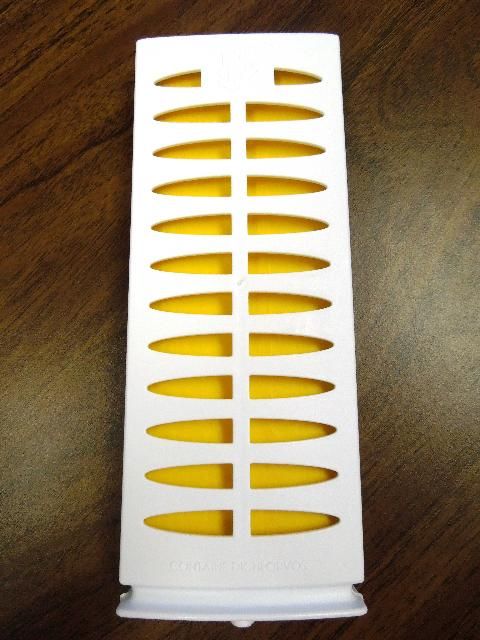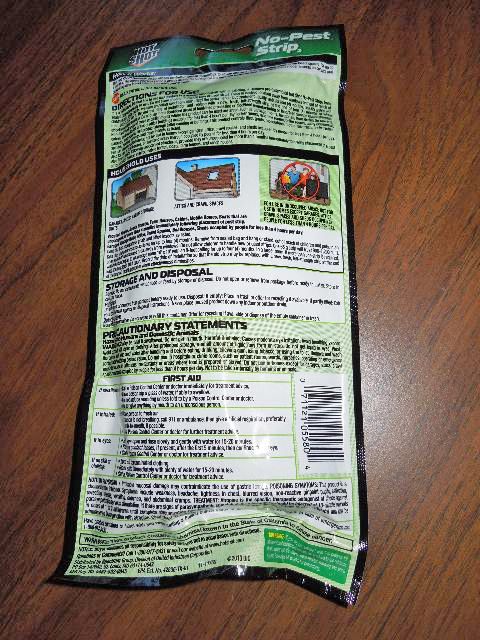Pest strips are commonly sold at many retail outlets and are available to anyone for purchase (Figure 1). Pest strips are constructed of resin plastic impregnated with insecticide. The insecticide is gradually control-released over time as a vapor. They have specific indoor residential uses for control of bed bugs, flies, gnats, moths, and other pests. The strips, in use since they were registered by Shell Chemical in 1954, are impregnated with dichlorvos (DDVP), an organophosphate insecticide. While the strips are commonly used, they should be considered and handled as any pesticide—according to label directions. Many of the organophosphate insecticides or their specific uses have been banned by the EPA because they posed unreasonable risks to children. As an insecticide class, the organophosphates act on a broad range of animals and insects because they inhibit acetylcholinesterase activity, an enzyme that regulates nerve impulses in the body.

Credit: UF/IFAS
Because pest strips deliver the insecticide as a vapor, dichlorvos is particularly suited for this use. Dichlorvos is relatively volatile, making it useful as a fumigant. It is effective because, if used correctly and according to label directions, it releases vapors for up to 4 months.
Acute illness in humans has been reported, most likely because users did not follow label directions. Between 2000 and 2013, 31 cases of illness associated with the use of DDVP pest strips were reported in Canada and the United States. Most of these cases involved violating product label directions by using the strips in occupied residential living areas. Fortunately, most of the reported illnesses were not severe—most commonly minor neurological, respiratory, and gastrointestinal symptoms—however, a few were more severe, requiring hospitalization. There are likely many more illnesses that went unreported.
Some points to consider when using pest strips:
- Do not hang strips in occupied areas of the home. The label states that they can be used in areas such as garages, attics, crawl spaces, and sheds; however, they should never be placed in any area of the home that will be occupied by people for more than 4 hours per day. Therefore, avoid using them in general living or sleeping areas. There is one exception: they may be placed in a home if the home will not be occupied for 4 months following placement.
- Do not hang too many strips. The number of strips to use depends on the volume of the space where strips will be placed. One product's label states that a single 65g strip is sufficient to treat 900 to 1,200 cubic feet for up to four (4) months, which is about equal to an average room measuring 10' x 13' with an 8-foot ceiling. In a larger room, if more than one strip is required, keep them at least 10 feet apart.
- Do not allow children or pets to play or sleep in areas where strips are hung.
- Never use strips in any area where food is prepared, served, or may be exposed.
- There are other DDVP products that are used for bed bug control. These are placed in large sealed bags containing bed bug-contaminated items such as mattresses, furniture, and luggage. These products should never be used as replacements for pest strips.
- Labels can be confusing. DDVP pest strips are offered in three different sizes: 16g, 65g, and 80g. Label directions differ across sizes, but can also differ across brands of the same size. Each product's directions for use are written for specific uses and those uses only. The issue is compounded by the fact that some labels of pest strip products are written in extremely small font sizes (Figure 2).
- Not all products are recommended for homeowner use, but are intended for use by pest management professionals. For example, Hot Shot® is intended for homeowners, but Nuvan® is for professional use only.
- Because pest strips contain DDVP, they are classified by the EPA as pesticides; pesticides should be handled with respect, and above all, used according to label directions.

Credit: UF/IFAS
Additional Information
Fishel, F.M. 2009. Pesticides and cholinesterase. PI-221. Gainesville: University of Florida Institute of Food and Agricultural Sciences. https://journals.flvc.org/edis/article/view/118256
Tsai, R.J., J. Sievert, J. Prado, K. Buhl, D. Stone, M. Forrester, S. Higgins, Y. Mitchell, A. Schwartz, and G. Calvert. 2013. Centers for Disease Control and Prevention: Morbidity and Mortality Weekly Report. 63(02):42–43. http://www.cdc.gov/mmwr/preview/mmwrhtml/mm6302a5.htm?s_cid=mm6302a5_w